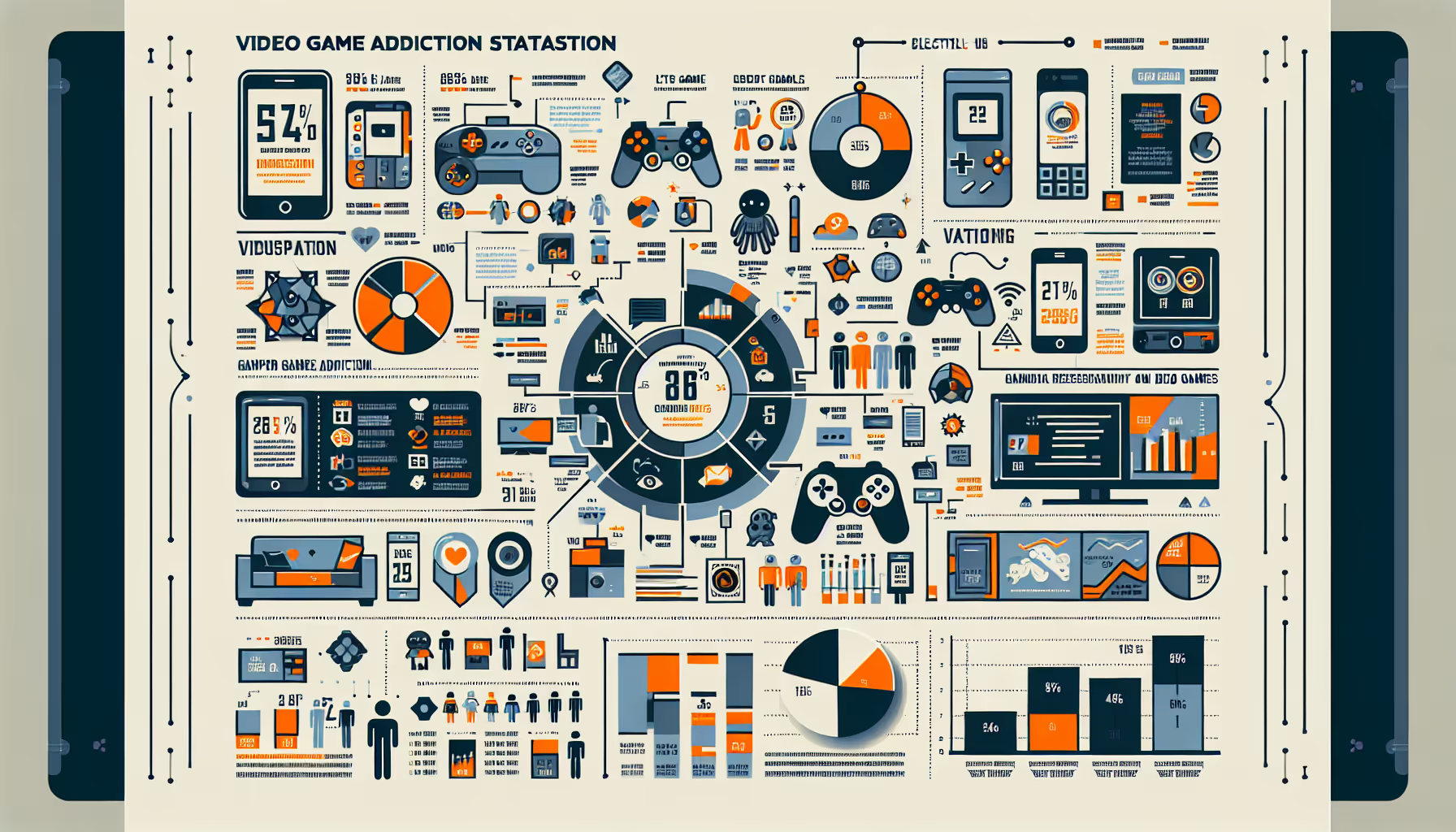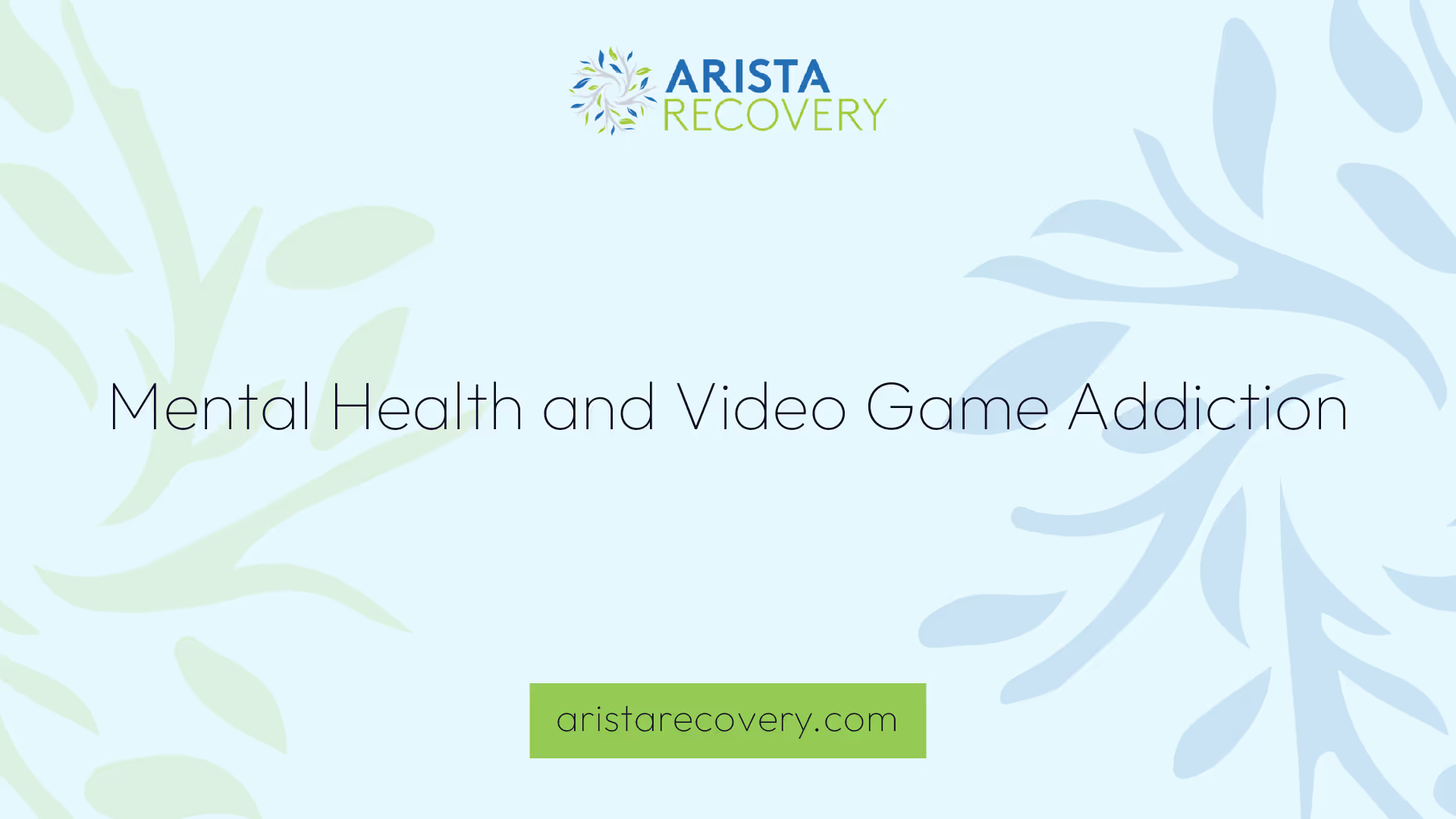Video Game Addiction Statistics & Facts


Understanding Video Game Addiction
Video game addiction is a growing concern that needs to be addressed. This digital dilemma impacts numerous lives across the globe, with the United States witnessing a significant prevalence. Understanding the scope and nature of this issue is crucial in developing effective measures to mitigate its impact.
Prevalence in the USA
In recent years, video game addiction has emerged as a significant issue in the United States. According to data from SAMHSA, the helpline received 833,598 calls in 2020, marking a 27% increase from the previous year when it received 656,953 calls. This data suggests a growing awareness and concern about addiction, including video game addiction.
As per the data from Addiction Help, video game addiction is estimated to affect between 1.7% and 10% of the American population. The broad range is attributed to the ongoing debate among researchers regarding the diagnostic criteria for internet gaming disorder.
For comparison with other addiction statistics, refer to our articles on statistics about drug abuse & facts, eating disorder statistics & facts, and current alcoholism statistics & facts.
Gender Disparities
While video game addiction can impact individuals regardless of their gender, research indicates that men or people assigned male at birth are more likely to develop this addiction than women or those assigned female at birth [1]. In fact, males account for approximately 75-90% of video game addiction cases.
These gender disparities in video game addiction highlight the need for gender-specific interventions and support systems. Understanding these disparities can also aid in improving the diagnostic and treatment approaches for video game addiction.
Understanding video game addiction, its prevalence, and the disparities among different demographics is the first step in addressing this issue. The next sections will delve deeper into the demographics and gaming trends, mental health implications, global insights, and treatment options related to video game addiction.
Demographics and Gaming Trends
A thorough understanding of video game addiction statistics & facts must include an exploration of the demographics and gaming trends. This involves assessing the ethnicity of gamers and the average time spent playing video games.
Ethnicity in Gaming
In the United States, the gaming community is diverse, with players from various ethnic backgrounds. According to Addiction Help, Caucasians make up the majority of U.S. gamers. Below is the distribution of gamers by ethnicity.
This data is crucial in understanding the extent of video game addiction across different ethnic groups and developing targeted interventions.
Average Gaming Hours
The average time spent playing video games is a crucial factor in understanding the prevalence of video game addiction. The Addiction Help reports that the average American gamer plays just over one hour daily, which translates to an average of 7.6 hours per week.
However, this average varies significantly by gender and age. Statistics from NCBI reveal that boys from the age of 14 use video games up to 5 times more than girls, while girls spend more time on social media. Moreover, boys spent significantly more time than girls in all age groups playing video games on consoles or computers.
These statistics underscore the need for targeted interventions and treatments for video game addiction, taking into account the different patterns of gaming behavior across various demographics. For more information on addiction statistics, check out our articles on statistics about drug abuse & facts, eating disorder statistics & facts, current alcoholism statistics & facts, and addiction relapse rates in the United States.

Mental Health and Video Game Addiction
The impact of video game addiction extends beyond the realm of physical health, reaching into psychological and neurological aspects as well. This section explores the psychological effects of video game addiction and presents findings from recent neurological research.
Psychological Effects
Impulsivity, poor self-control, anxiety, and the pursuit of desired appetitive goals are psychological features associated with Internet Gaming Disorder (IGD). It has been found that female gamers are more likely to develop poor mental health and psychiatric comorbidities than males. Attention Deficit Hyperactivity Disorder (ADHD) is also a risk factor for IGD, especially in males.
Video game addiction has also been linked to other mental health problems such as loneliness and hyperactivity, making individuals more likely to develop an addiction to video games [1]. Furthermore, a study has shown that computer games addiction has a direct significant relationship with anxiety, leading to increased heart rates and blood pressure in players, as well as causing physical damages and mental health issues [4].
These findings suggest a close link between video game addiction and various psychological issues. While these statistics and facts on video game addiction are concerning, it's important to remember that they can also provide valuable insights for prevention and treatment strategies.
Neurological Research Findings
Recent neurological research has found similarities in the brains of people with video game addiction and substance use disorders. This suggests that video game addiction could have similar neurobiological mechanisms as other forms of addiction, further highlighting the seriousness of this issue.
The research findings on the neurological aspects of video game addiction are still in the early stages. However, they provide valuable insights that could help in the development of more effective treatment methods for video game addiction.
For further reading on addiction statistics and facts, feel free to explore our articles on statistics about drug abuse & facts, eating disorder statistics & facts, current alcoholism statistics & facts, and addiction relapse rates in the united states.
Global Insights on Video Game Addiction
Understanding the global scope of video game addiction can provide valuable insights into how this issue affects different regions and countries. This information can assist researchers, policymakers, and healthcare professionals in creating effective strategies for prevention and treatment.
Regional Statistics
Video game addiction is not confined to any one region, affecting individuals across the globe. For instance, Asia, a region known for its robust gaming culture, suffers from the prevalence and impact of video game addiction as per the statistics and facts available. Recognizing the significance of the problem, the World Health Organization officially recognized "Gaming Disorder" as a mental health condition in 2019, with plans to add it to the International Classification of Diseases, ICD-11, in 2022.
In order to address this problem more effectively, it is important to understand its similarities and differences with other forms of addiction. You can learn more about this from our articles on statistics about drug abuse & facts, eating disorder statistics & facts, and current alcoholism statistics & facts.
Country-Specific Data
Diving deeper, we can examine the video game addiction statistics & facts on a country level. In the United Kingdom, for instance, the situation is significant enough to warrant detailed analysis.
Meanwhile, in the United Arab Emirates (UAE), it is estimated that there are over 7 million gamers, with between 137,200 and 210,000 Emiratis struggling with gaming addiction. The recent pandemic has led to a significant increase in gaming addiction, with more people spending time gaming during lockdowns.
These numbers underline the seriousness of the issue and the need for concerted actions to manage and address video game addiction. It is worth noting that the relapse rates for gaming addiction can be as significant as for other forms of addiction, as discussed in our article on addiction relapse rates in the united states.

Diagnosis and Treatment
In the realm of video game addiction statistics & facts, understanding the process of diagnosis and available treatment options is crucial. This section aims to provide an overview of these aspects.
Diagnostic Process
To be diagnosed with video game addiction, officially known as internet gaming disorder (IGD), a healthcare provider may refer the individual to a mental health professional such as a psychologist or psychiatrist. These professionals use the American Psychiatric Association's Diagnostic and Statistical Manual of Mental Disorders (DSM-5) to diagnose mental disorders, which includes information about internet gaming disorder.
The American Psychological Association defines IGD as experiencing at least five of nine criteria over a 12-month period. These criteria include factors like withdrawal symptoms when gaming is taken away, giving up other activities to game, and continued gaming despite problems it causes.
Treatment Options
Once a diagnosis of video game addiction has been made, the next step is treatment. The primary treatment option for video game addiction is talk therapy (psychotherapy). Specifically, cognitive-behavioral therapy (CBT), dialectical behavior therapy (DBT), and family therapy are types of psychotherapy that may benefit someone with video game addiction.
These therapeutic approaches are designed to help individuals understand their addiction, develop coping strategies, and work on behavioral changes. Family therapy involves family members in the treatment process to help create a supportive environment for the individual battling the addiction.
However, it's important to note that the field of IGD treatment is still evolving. Current approaches can include education, harm reduction, stricter labeling, and cognitive-behavioral therapy. Further research is needed to evaluate the effectiveness of these treatments and develop new strategies.
As with other forms of addiction treatment, such as those for drug abuse statistics about drug abuse & facts, eating disorders eating disorder statistics & facts, or alcoholism current alcoholism statistics & facts, it's crucial to remember that recovery is a process and relapse is not uncommon addiction relapse rates in the united states. It's important to seek professional help when needed and to be patient with the recovery journey.
Impact on Physical Health
The physical health implications of video game addiction are an important part of understanding the overall impact of this issue. Prolonged gaming can lead to a number of health problems, including obesity, vision issues, and sleep disorders.
Obesity and Sedentary Behavior
One of the main physical concerns associated with video game addiction is obesity. Due to the sedentary nature of video gaming, those who spend a significant amount of time playing games may lack sufficient physical activity. This, coupled with increased food intake while playing video games, can contribute to obesity. While this association has been particularly noted in teens, it is plausible that similar results would be observed in adults.
These findings draw parallels with other forms of addiction, such as drug abuse, alcoholism, and eating disorders, which also have significant impacts on physical health. For more information on these topics, see our articles on statistics about drug abuse & facts, current alcoholism statistics & facts, and eating disorder statistics & facts.
Vision and Sleep Issues
Video game addiction may also lead to vision and sleep problems. Gamers often complain of eye strain, which can lead to headaches and poor concentration. In rare instances, gaming has even been reported to trigger seizures.
In addition to these physical health concerns, video game addiction has been shown to have significant psychological effects. It has been linked to anxiety, which can lead to increased heart rates and blood pressure in players, and potentially cause physical damage and additional mental health issues [4].
Overall, the physical health impacts of video game addiction highlight the need for balanced gaming habits and the importance of seeking help when gaming begins to interfere with daily functioning and well-being. More research is needed to fully understand the scope of these health implications and to develop effective treatments for those struggling with video game addiction.
Age and Gender Differences
Understanding the 'video game addiction statistics & facts' involves an examination of both age and gender variances. This approach helps establish a comprehensive picture of this modern form of addiction.
Age Groups Affected
Video game addiction can affect people of all ages, but it is most problematic in individuals aged 34 and younger. The average age of a video game addict is 24 years old, according to Game Quitters. The percentage of American children playing video games is now over 90%, thus exposing more young people to the risks of video game addiction.
The prevalence of Internet Gaming Disorder (IGD) varies worldwide, with most studies showing a higher prevalence among young people.
Gender Variances
When it comes to gender, studies have shown that males are usually more susceptible to video game addiction than females. Males primarily play shooting and role-playing games, are more attracted to violent and competitive elements without social interactions, and exhibit more aggressive feelings than females. Females, on the other hand, prefer simulation games and spend more time on social media than gaming [3].
Impulsivity, poor self-control, anxiety, and the pursuit of desired appetitive goals are psychological features associated with IGD. Notably, female gamers are more likely to develop poor mental health and psychiatric comorbidities than males. ADHD is also a risk factor for IGD, especially in males.
Furthermore, studies have shown that there are sex differences in the brain regions involved in IGD, such as the prefrontal region, posterior cingulate cortex, regions involved in visual processing and cognitive control, and the mesocorticolimbic reward system. These differences are important for understanding the neural correlates of IGD and the potential role of hormones in the disorder.
Understanding the relationship between age, gender, and video game addiction allows for more accurate diagnoses and effective treatment. Like other forms of addiction, including drug abuse, eating disorders, and alcoholism, video game addiction requires a multi-faceted approach that considers all aspects of an individual's identity and their unique circumstances. By doing so, we can better understand, prevent, and treat these addictive behaviors.
Future Perspectives
As we delve further into the digital age, our understanding and treatment of conditions like video game addiction continue to evolve. Future perspectives in this field are primarily shaped by evolving definitions of the condition and the development of new treatments.
Evolving Definitions
In 2019, the World Health Organization recognized "Gaming Disorder" as a mental health condition, which will be officially added to the International Classification of Diseases, ICD-11, in 2022 [6]. This official recognition of the disorder is a significant step forward in addressing video game addiction's impact on mental health.
It's important to note that video gaming addiction is most problematic in individuals aged 34 and younger, with the average age of a gaming addict being 24 years old. The percentage of American children playing video games is now over 90%, exposing more young people to the risks of video game addiction.
While the distribution of gamers between genders is almost even, with 50% male and 48% female, 94% of gaming addicts are males, indicating a higher prevalence of gaming addiction among males. This could be related to how males perceive gaming cues in their brains, leading to higher cravings and addiction.
Developing Treatments
As recognition and understanding of gaming disorder increase, efforts to develop effective treatments gain momentum. Between 0.3% and 1.0% of Americans might have an internet gaming disorder, according to a study from the American Journal of Psychiatry. Treatments for this problem are still in progress and can include public health approaches, stricter labeling on packaging, and cognitive behavioral therapy.
The estimated number of gamers worldwide was 1.9 billion in 2015, increased to 2.81 billion in 2021, and is anticipated to surpass 3 billion by 2023. This growth indicates a potential increase in the number of gamers suffering from gaming disorder each year, emphasizing the need for effective treatments.
It's crucial to monitor this growing trend and invest in research to better understand the nature of gaming addiction and develop effective treatments. For more insights on addiction, you can explore our articles on statistics about drug abuse & facts, eating disorder statistics & facts, current alcoholism statistics & facts, and addiction relapse rates in the united states.
References
[1]: https://www.addictionhelp.com/video-game-addiction/statistics/
[2]: https://www.niagararecovery.com/blog/video-game-addiction-statistics
[3]: https://www.ncbi.nlm.nih.gov/pmc/articles/PMC8877403/
[4]: https://www.ncbi.nlm.nih.gov/pmc/articles/PMC3905489/
[5]: https://my.clevelandclinic.org/health/diseases/23124-video-game-addiction
[6]: https://gamequitters.com/video-game-addiction-statistics/
[7]: https://www.health.harvard.edu/blog/the-health-effects-of-too-much-gaming-2020122221645
You’re not alone in this.
When mental health challenges and addiction intersect, it can feel isolating. At Arista, we offer compassionate, evidence-based, and trauma-informed care to help you heal, grow, and move forward.
You’re not alone in this.
When mental health challenges and addiction intersect, it can feel isolating. At Arista, we offer compassionate, evidence-based, and trauma-informed care to help you heal, grow, and move forward.
Support that moves with you.
You’ve taken a brave first step. At Arista Recovery, we’re here to help you continue with best-in-class care designed for long-term healing and support.
.webp)






